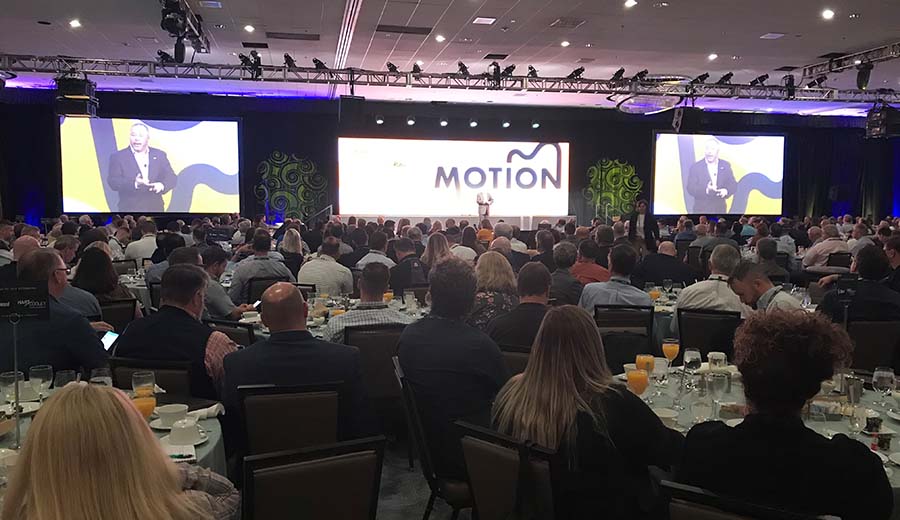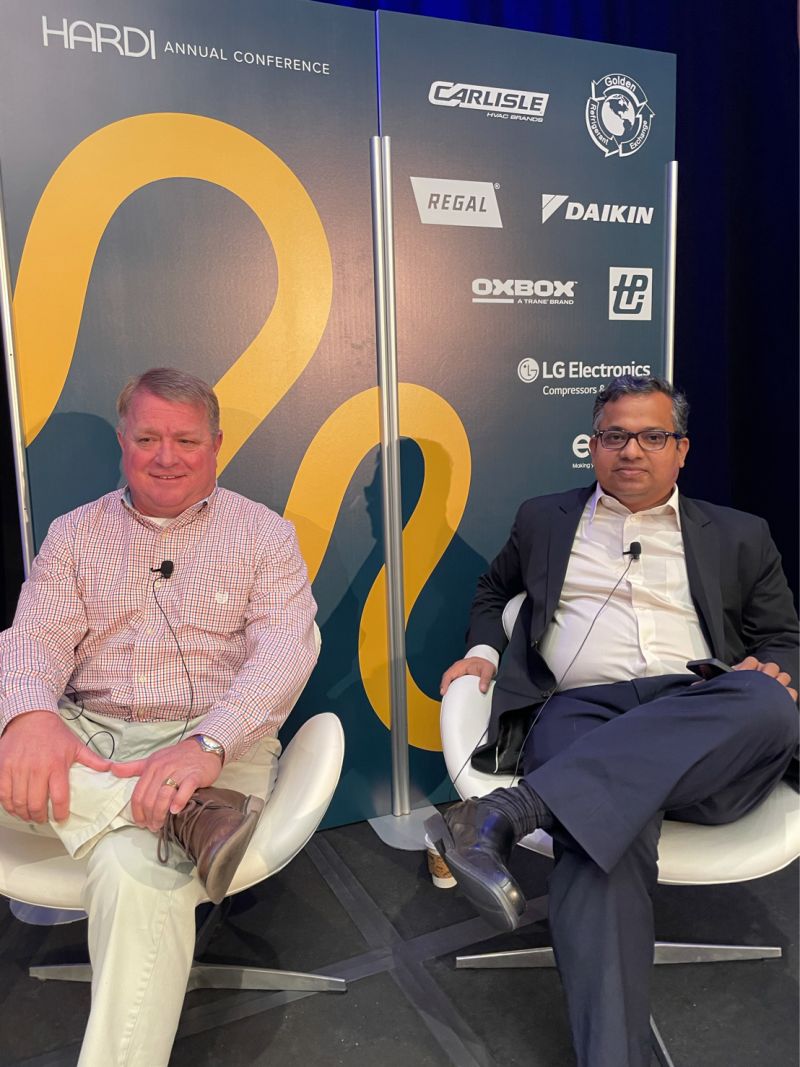PALM DESERT, CA — “The hardest years we have perhaps ever seen with unprecedented disruption in the channels. However, other industries are studying how you did it — how you managed to grow this industry through it all.”
Talbot Gee, HARDI CEO, kicked off the opening session of the HARDI Annual Conference at the J.W. Marriott, Palm Desert, nearly exploding on stage with pent-up energy in front of a record-setting audience of 1,485 HVAC distributors/wholesalers, manufacturers reps, and suppliers. Two years since their last annual conference, delayed by a pandemic, challenged by a labor shortage and supply chain woes, all the membership cut loose with enthusiasm for live professional content and fun with their colleagues.

Talbot Gee, Chairman and CEO, HARDI, opened the Annual Conference nearly himself overwhelmed with excitement for the first annual gathering in two years and a record-setting attendance. (Staff photo)
“Motion: Find Your Direction” was the conference theme of the four-day event. The first day included town hall meetings for suppliers and distributors, a Women in HVACR session, a first-timers orientation, and a day on the links for those seeking some desert golf to benefit Homes for Our Troops. The final three days were dedicated to specific learning sessions that accentuated the three facets of the meeting: Catalyst — forces igniting motion; Friction — forces slowing progress; Acceleration — forces enabling quick industry response.
Opening keynote speaker Lisa Bodell, FutureThink CEO, ranks among the top 50 speakers worldwide and is the best-selling author of “Kill the Company” and “Why Simple Wins.” She’s a global leader of simplification, productivity, and innovation. She arms audiences with radically simple tools to take back home to the business. However, Bodell’s was not a simple speech of the traditional “change” variety.
“We just created change that may have normally taken 10 years, but we did it at unprecedented speed,” she said. “COVID rocked us into a massive awareness of change. Typically, we don’t see change as it occurs — that’s why it’s so hard. Change is disliked by all of us, but truly we are always navigating change even though we don’t think of it that way. To take advantage of change, we should always challenge the norm along the path so it’s like turning a dimmer switch up rather than throwing a breaker switch on and off. That’s managing the course of change to your benefit.”
She presented the HARDI membership with five tactics but suggested the group to work on only one in order to effect a change mentality, rather than bombard the home team with too many changes at once.
“Remember? No one likes change. Make it a process. Pick one of these to work on,” said Bodell.
Meeting Highlights
During the third annual Voice of the Contractor presentation of survey results, T.J. O’Connor, Farmington Consultants, revealed that HVACR contractors affirmed in both 2019 and 2020 that product availability and price are the most important variables they consider when evaluating the performance of a distributor. One key takeaways from O’Connor’s presentation included distributor and brand loyalty. “The recent product shortages/supply chain challenges are absolutely changing both distributor loyalty and brand loyalty,” O’Connor said. “Two out of every three HVACR contractors state that they will be doing more business long-term with distributors who have had greater in-stock availability through the recent product shortages. Additionally, three out of every four are willing to buy a substitute equipment brand due to shortages. With that said, the distributors who can find ways to supply products to their secondary and tertiary customers when they are in need will take market share from their competitors long-term.”
O’Connor also revealed to the audience that contractors are serving additional industries. Those serving HVAC only, 28%; refrigeration, 24 %; plumbing, 23 %; electrical, 14%; other, 11%. The “other” category represented boilers, generators, duct cleaning, appliances, IAQ, radiant, sheet metal, hearth, and general contracting.
Refrigerant Changes
No industry meeting would be complete without touching upon the multitude of issues surrounding refrigerant changes. During one of about five such related sessions, Rusty Tharp, director of regulatory affairs, Goodman Manufacturing, discussed new refrigeration leak detectors that will be required on most A2L systems.
“These will mainly be handled by the manufacturers at the design stage, but also distributors will have to stock some that are for field installation,” he said, meaning that contractors will be training installation teams on new practices for some systems.
A refrigerant reclaim session was moderated by Dale Norton, vice president of Meier Supply, and included California contractor participant Don Langston, president/CEO of Aire-Rite A/C.
Langston said, “If we have to open up a system, we have no idea what we are going to encounter. If someone happened to put an R-22 drop-in on top of R-22, even that is considered contaminated.”
The matter of contamination is perhaps the basis of the biggest problem with reclaim. With up to 10 cylinders that a contractor may carry to accommodate a variety of refrigerants (depending upon their scope of business), it’s an expensive investment. Contractors, distributors, and the reclaim companies all face challenges to turn reclamation into a revenue stream. The mixing of refrigerants in the systems or the mixing within reclaim tanks transported on service vehicles is costly on all fronts.
When asked how distributors can help, Langston said, “First, having the conversation is the start. Any incentive to create a financial benefit to contractors to work with technicians to do the right thing will be key to successfully increasing the amount of reclamation.”
More Meeting Highlights
There were more than 50 educational sessions and networking events for HARDI members to learn and share ideas. For example, Scott Pierson, executive vice president at Bluon Inc., a technician membership platform, dove into the results of Bluon’s Voice of the Technician survey and highlighted the differences and similarities between contractor and service technician preferences. Talbot Gee moderated a panel discussion on distributor consolidation and escalating levels of merger and acquisition activity. Mike Murphy, publisher of The ACHR NEWS, moderated a panel discussion on contractor consolidation. Two players in the HVAC industry joined in that discussion: Ashish Achlerkar, Near-U Services, and Patrick Lange, Business Modification Group.

Patrick Lange, Business Modification Group, and Ashish Achlerkar, Near-U Services, discussed activity of recent years. They shared their experiences during the HARDI Annual Conference. (Staff photo)
Anirban Basu, chairman and CEO, Sage Policy Group, entertained and educated the membership during his luncheon keynote. He is well known for his Morning Economic Report on WYPR, an NPR news station.
Basu said, “People will come back to work as inflation affects ability to pay their bills. Some avoided working for two years and got used to it — that will stop. We’ve been adding jobs back to the economy but at a much slower pace of late. It’s like Humpty Dumpty. The economic egg was broken and it’s very hard to put back together again.”
Basu covered a variety of topics including labor markets, financial markets, real estate, construction, consumer spending, business investment, international trade, and government finances.
The Solutions Center was open Sunday and Monday, providing distributors with answers to business needs from 33 participating service vendors. These one-on-on interactions afforded attendees an opportunity to learn new techniques, technologies and more efficient ways for customers to manage and grow their businesses. More than 150 vendors exhibited during the HARDI Booth Program. Approximately 30 vendors sponsored the annual conference, including The ACHR NEWS.
More information about the event can be found at www.hardinet.org.
How Successful Teams Change
- Challenge the way they work
- Engage with purpose
- Eliminate stupid rules
- Prioritize what matters
- Operate with intention



Report Abusive Comment